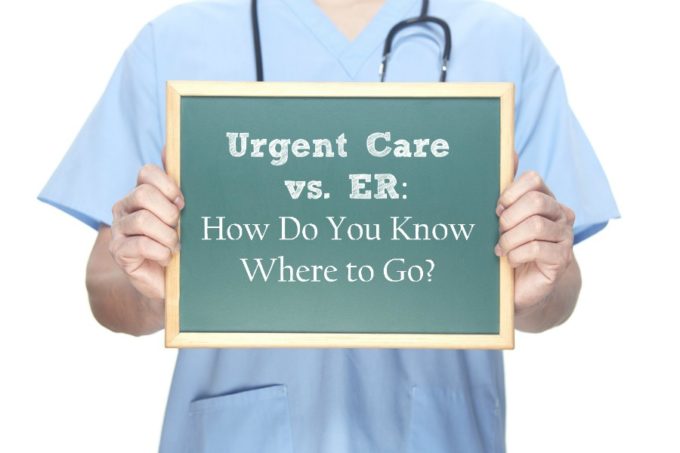This post is brought to you by the Urgent Care Association of America (UCAOA). All opinions are my own.
Urgent care vs. the ER: how do you know where to go? It’s something I’ve found myself trying to figure out a few times, and more than once I made the wrong choice. I’ve spent hours in the ER when a quick trip to urgent care would have been sufficient, and I’ve gone to urgent care only to be told that the type of injury required emergency room treatment.
In fact, just last week, I took Jake to urgent care after he and Freya knocked heads hard enough to give Jake a gash and a black eye (Pharaoh Hounds have very hard heads!). They were playing, she took off on one of her “crazy dog” runs (picture a Greyhound dog running, Freya is almost as fast), Jake didn’t move in time and BOOM. Since the injury was so close to his eye, they sent me over to the ER. He’s okay. It bled like crazy but turns out it was actually a pretty small cut.
Urgent Care, ER or Other OnDemand Healthcare: How do You Know Which is Right?
When your child is sick or injured, your first instinct is to fix it…immediately. To most of us, that means rushing to the ER. After all, that’s where our parents took us when we were seriously hurt or ill. When we get there, we usually end up waiting for hours. Waiting to register, waiting for triage, waiting to be taken back, waiting for a doctor…waiting, waiting, waiting. Knowing the difference between urgency vs. emergency not only saves time and money, it helps our kids (or us!) get the care we need much faster.
In the last decade, urgent care centers have popped up all over my area. I bet you’ve seen a ton of them appear in your town, too. Unless you live in a city or huge town, chances are you only have close access to one or two hospitals with emergency departments. On the other hand, you now have access to up to a dozen or more urgent care facilities, clinics, and even telemedicine options. So how do you know where to go? The Urgent Care Association of America (UCAOA) gave me some great information to share with you to help you decide.
Urgency vs. Emergency
When you’re trying to figure out where to go, the UCAOA recommends considering the three C’s: care, convenience, and cost. Let’s look at them a little closer.
- Care: The very first thing to do is figure out how severe the symptoms are. If you even remotely feel like it’s a life- or limb-threatening issue, head to the ER. I’ve learned over the years that injuries involving the head (including the eyes) or illnesses that include abdominal pain are also almost always ER issues. Most other issues can be managed by other options.
- Convenience: Choosing the most convenient option isn’t just about saving time. When our kids are sick, we have all the time in the world to make sure they’re cared for properly. To me, convenience is also about getting my son seen faster. Know which healthcare facilities are within close driving distance and make a note of their hours.
- Cost: Again, it’s hard to think about money when you’re trying to make sure your family is okay The sticker shock comes later, when everything is calm. Make a list ahead of time of facilities that accept your insurance, and find out if there are any co-pays or pre-authorization requirements.
Which urgent care option should you choose?
Okay, so you’ve decided that the injury is definitely an urgent care vs. ER issue. So now it’s time to head to your nearest urgent care that takes your insurance, right? Not so fast! You still have more options available to you. ER-alternatives include:
Urgent Care Centers
Obviously, right, since that’s what we’ve been talking about! These centers are good for those injuries and illnesses that feel like they need immediate attention but don’t really feel like emergencies. I’ve taken Jake to urgent care for issues like a hurt foot that clearly wasn’t broken and a severe head cold that I thought could be the flu. I’ve also gone myself when I had an earache that made my head feel like it was going to explode. Many urgent care facilities have the basics, like x-rays and on-site lab tests.
Retail Clinics
Retail clinics, also called walk-in clinics, are those usually found in your grocery store or local pharmacy. They’re best for minor illnesses (like the common cold) or for vaccinations.
Telemedicine
Sometimes, you can get checked out without ever even leaving your house! Some telemedicine options are run by urgent care centers, so you can do a follow-up without going back in. Others are independently run and can diagnose basic illnesses based on your symptoms and a physical exam over video chat.
Sometimes it’s hard to tell the difference between the options (with the exception of telemedicine, I mean, you pretty much KNOW that you’re calling versus visiting!). It’s even more confusing when you mix in free-standing emergency rooms, which are NOT the same thing as urgent care centers. According to UCAOA, an urgent care center will identify itself as such (or as an immediate care center). You can find them near you by visiting www.whereisurgentcare.com.
I hope this helps you figure out when to use an urgent care or other on-demand medical option versus when to go to the ER. Once you know about the options available to you, it really does come down to what you are most comfortable with. If you truly feel like it is an ER situation, trust your gut. If you’re on the fence and feel like the decision can wait a few minutes, call your regular doctor and ask.
For more information about urgent care, visit www.ucaoa.org.








